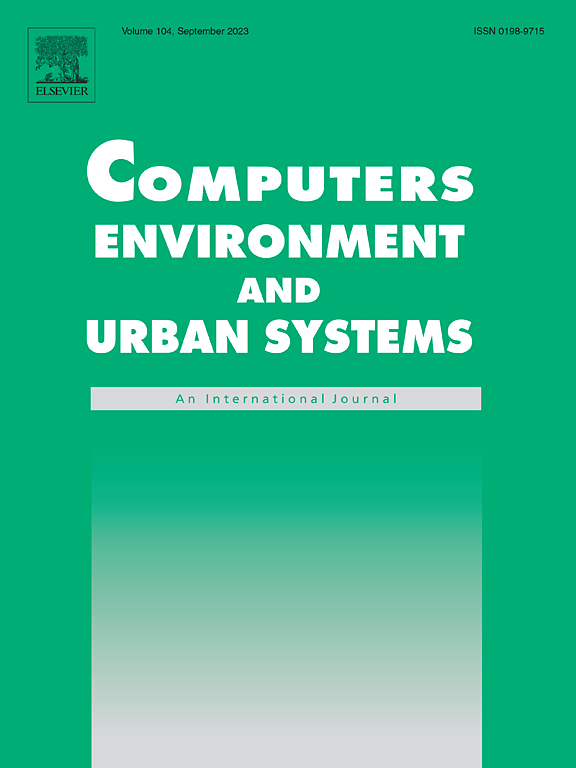探索建筑环境对网约车等候时间的影响:北京的实证研究
IF 7.1
1区 地球科学
Q1 ENVIRONMENTAL STUDIES
Computers Environment and Urban Systems
Pub Date : 2024-11-05
DOI:10.1016/j.compenvurbsys.2024.102205
引用次数: 0
摘要
研究表明,网约车等候时间(CWT)与城市建筑环境(BE)密切相关。兴趣点(POI)数据被广泛用于描述建筑环境的特征。然而,如何量化不同类型 POI 之间的适当组合或空间关系,以捕捉区域内建筑环境的功能特征,是一项挑战。本文提出了一个基于语义概率主题模型的建筑环境特征分析框架,该框架利用潜在德里希勒分配(Latent Dirichlet Allocation)技术,证明了将 POI 的建筑面积与其所在位置的旅行活动强度相结合,可以更精确地识别区域功能。此外,虽然一些研究探讨了建筑环境与等待时间之间的相关性,但很少有研究对两者之间的非线性相互作用进行评估。在此基础上,我们利用机器学习技术 XGBoost 模型,结合在线叫车订单数据,探究了建筑环境与等候时间之间的关系。研究表明,CWT 受多种因素的综合影响。以工作日晚高峰为例,商业和办公用地密集的中城区的候车时间与商业和办公主题正相关,而与教育、居住、休闲和医疗保健主题负相关,导致中城区的候车时间更长。此外,BE 之间的相互作用会削弱其对 CWT 的单独影响。较高程度的职住平衡可以减轻居住和办公主题对延长 CWT 的负面影响,尤其是在中城区。此外,BE 主题还可能抑制道路密度对降低 CWT 的积极影响。BE 与 CWT 之间的关系表现出阈值效应和 V 型关系,表明 BE 仅在特定范围内与 CWT 显著相关。这种相关性还表现出从中心城区到郊区的梯度模式,尤其是在办公楼和住宅主题方面。这些结果阐明了对等候时间产生重大影响的建筑环境的突出范围,为网约车调度和城市发展的战略规划提供了参考,从而提高乘客的出行满意度。本文章由计算机程序翻译,如有差异,请以英文原文为准。
Exploring the built environment impacts on Online Car-hailing waiting time: An empirical study in Beijing
Waiting time is a critical metric for evaluating the quality of online car-hailing services, with studies indicating a close association between Online Car-hailing waiting time (CWT) and the urban built environment (BE). Points of interest (POI) data is widely utilized to characterize the built environment. However, quantifying the proper combination or spatial relationships between different types of POIs to capture the functional features of the built environment within a region poses a challenge. This paper proposes a framework for analyzing built environment characteristics based on a semantic probabilistic topic model utilizing Latent Dirichlet Allocation, demonstrating that integrating the building area of POIs along with the travel activity intensity at their respective locations enables a more precise identification of regional functions. Moreover, while some studies have explored the correlation between the built environment and waiting time, few have evaluated the nonlinear interactions between them. On this foundation, employing the machine learning technique XGBoost model in conjunction with online car-hailing order data, we probe the relationship between the built environment and waiting time. The research indicates that CWT is comprehensively affected by multiple factors. Taking weekday evening peak period as an example, the CWT of Central-urban area, where has dense commercial and office land use, positively correlated with commercial and office topics, while negatively correlated with educational, residential, leisure and healthcare topics, leading to a longer CWT in the Central-urban. In addition, the interaction between BEs can weakens their individual effects on CWT. A higher degree of job-residence balance can mitigate the negative impact of residential and office topics on increasing CWT, particularly in Intermediate-urban areas. Additionally, BE topics may also suppress the positive effect of road density on reducing CWT. The relationship between the BE and CWT exhibits threshold effects and a V-shaped relationship, indicating that the BE is significantly associated with CWT only within specific ranges. This correlation also exhibits a gradient pattern from the Central-urban to the Sub-urban, especially concerning office and residential topics. These outcomes elucidate the salient ranges of the built environment that exert substantial impacts on waiting time, informing strategic planning for online car-hailing dispatch and urban development to augment passenger travel satisfaction.
求助全文
通过发布文献求助,成功后即可免费获取论文全文。
去求助
来源期刊

Computers Environment and Urban Systems
Multiple-
CiteScore
13.30
自引率
7.40%
发文量
111
审稿时长
32 days
期刊介绍:
Computers, Environment and Urban Systemsis an interdisciplinary journal publishing cutting-edge and innovative computer-based research on environmental and urban systems, that privileges the geospatial perspective. The journal welcomes original high quality scholarship of a theoretical, applied or technological nature, and provides a stimulating presentation of perspectives, research developments, overviews of important new technologies and uses of major computational, information-based, and visualization innovations. Applied and theoretical contributions demonstrate the scope of computer-based analysis fostering a better understanding of environmental and urban systems, their spatial scope and their dynamics.
 求助内容:
求助内容: 应助结果提醒方式:
应助结果提醒方式:


